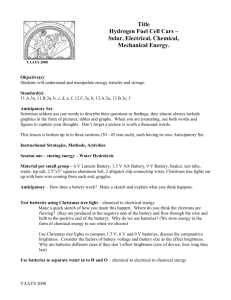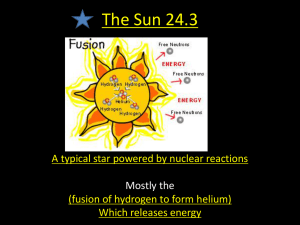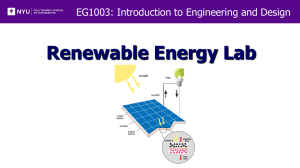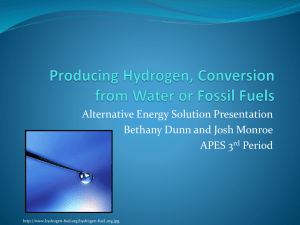Solar Powered Hydrogen Fuel Cell Project PPT
advertisement
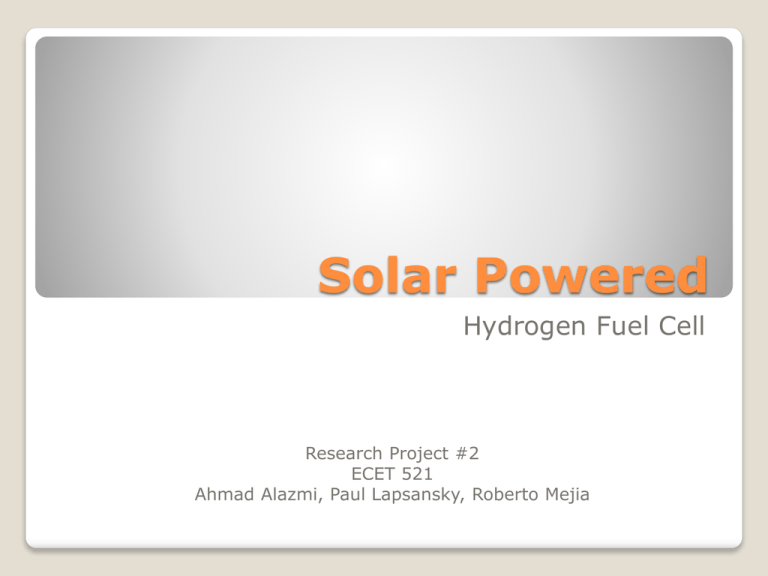
Solar Powered Hydrogen Fuel Cell Research Project #2 ECET 521 Ahmad Alazmi, Paul Lapsansky, Roberto Mejia Fuel cells are devices for generating electric power. They share many of the characteristics of a battery: silent operation, no moving parts and a electrochemical reaction to generate power. Produce electricity by combining hydrogen and oxygen over a catalyst such as platinum. There are several different types of fuel cells but the most researched type is the proton exchange membrane (PEM) fuel cell which contains platinum for its catalyst. PEM fuel cells are capable of replacing batteries or generators in portable equipment and vehicles. What is a fuel cell? Different types of fuel cells Solar Powered Hydrogen Fuel Cell PEM Fuel Cell Our Hydrogen Fuel Cell One foot of platinum coated nickel wire (catalyst)…$15 A popsicle stick or similar small piece of wood or plastic. 9V solar panel…$20 A glass of water (electrolyte). A volt meter. Parts List Electrolysis of water into hydrogen and oxygen gasses via electricity from the solar panel. Recombining of the hydrogen and oxygen to produce electricity. How does it work? Negative Node Electrolysis • • • The electrode connected to the negative side of the solar panel has electrons that are being pushed by the solar panel. Electrons in the electrode combine with water molecules. The water molecules each give up a hydrogen atom, to form molecules of hydrogen (H₂), leaving negatively charged ions of OH-. Positive Electrode Electrolysis • • • Positive side of the solar panel pulls electrons from the water molecules. The water molecules split into positively charged hydrogen atoms (single protons), and oxygen molecules (O₂). The oxygen molecules form bubbles at the electrode, and the protons migrate away from the positively charged electrode. When we remove the solar panel, the catalytic action of the platinum causes the hydrogen (H₂) molecules to break up, forming positively charged hydrogen ions (H+, or protons), and electrons. At that other electrode, the oxygen molecules in bubbles on the platinum surface draw electrons from the metal, and then combine with the hydrogen ions (from the reaction at the other electrode) to form water. Fuel Cell The oxygen electrode has lost two electrons to each oxygen molecule. The hydrogen electrode has gained two electrons from each hydrogen molecule. The electrons at the hydrogen electrode are attracted to the positively charged oxygen electrode. Electrons travel more easily in metal than in water, so the current flows in the wire, instead of the water. In the wire, the current can do work, such as moving a meter. Electricity Produced Practical Applications of Solar Powered Hydrogen Fuel Cells EPA estimated mileage: 60 MPK Estimated range: 240 miles Limited release $600/month lease Honda FCX Clarity Honda has begun work on a domestic solar-powered hydrogen refueling station that is smaller and intended to fit within the home's garage. Designed to work in conjunction with Honda's FCX Clarity vehicle, the charging station is also compatible with a "Smart Grid" energy system. Honda Personal Refueling Station Solar-Powered Public EV and FCX Charging Station Solar powered hydrogen fuel cell bus Simple and inexpensive to build. Safe to use (only uses ordinary tap water). Requires platinum (which is expensive) for the catalyst. Clean source of energy (only by-product is water). PEM fuel cell is the most widely used and researched. Conclusion


